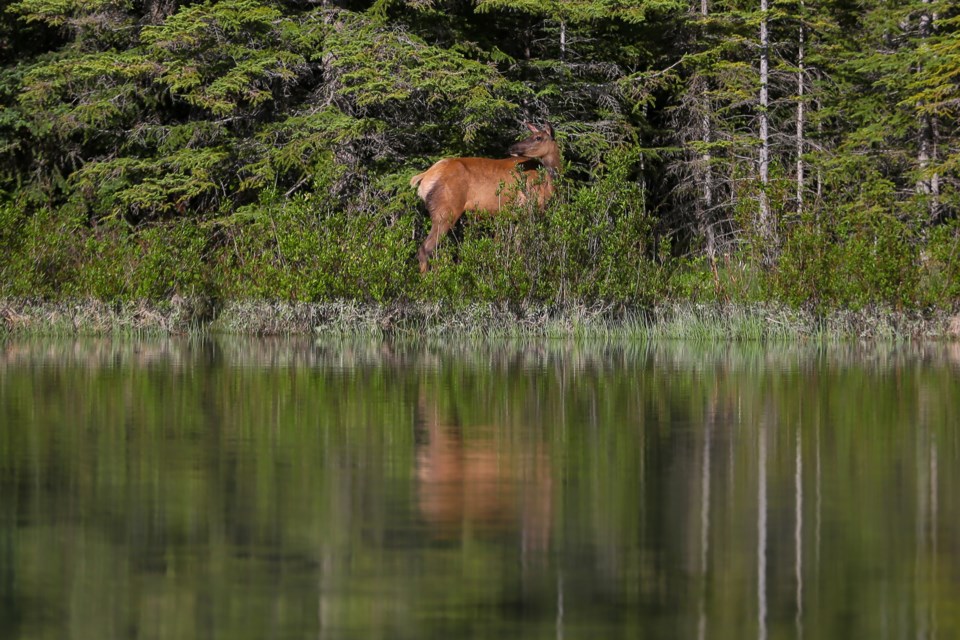CANMORE, Alta – Provincial Fish and Wildlife officers have been forced to euthanize a sick and debilitated adult female elk later diagnosed with a bacterial disease rarely found in elk.
The elk carcass was taken to a lab in Calgary where testing confirmed its untimely death was due to a clostridial disease, which has also been documented in a handful of elk in neighbouring Banff National Park.
“I can’t say it hasn’t been identified before (outside the park), but this is the first time in 22 years I’ve ever interacted with it,” said Mark Hoskin, a district Fish and Wildlife officer.
A handful of suspicious deaths in Banff’s elk herd, which carries the liver fluke parasite, were discovered in the national park over the past two years, including one carcass found near the Banff recreation grounds in January.
Necropsies, which are surgical examinations of dead animals, and Parks Canada’s wildlife veterinarian working with a pathologist, were able to determine the cause of death was clostridial disease.
These were the first known documented cases of the disease in elk in Canada, although that doesn’t necessarily mean the disease is only found here; it may mean it hasn’t been diagnosed elsewhere.
In the recent Canmore case, Hoskin said the female elk was euthanized on June 7 near the Rundle neighbourhood on the south side of Canmore.
“It was laying down and it would not get back up… it was rocking its head back and forth,” Hoskin said.
“Its neck looked like a lather; you know, a horse when it has been running hot too long and it looks like it’s lathered.”
Clostridial diseases are caused by anaerobic bacteria that are widespread in the environment, particularly in soil, and can be fatal.
Margo Pybus, Alberta’s provincial wildlife disease specialist, said the elk diagnosed with clostridial disease also had giant liver flukes, a naturally occurring parasite prevalent in elk in Banff National Park and spilling into the Canmore area.
“My understanding is all of the infected elk have had giant liver fluke as a predisposing factor,” said Phybus, who co-authored a 2015 research paper titled An Expanding Population of the Giant Liver Fluke in Elk and Other Ungulates in Canada.
“It’s a real interesting animal in that it lives in the liver, but it kind of chews its way through the liver. It kind of lays the foundation or provides the opportunity for the clostridium bacteria, which are fairly common environmental contaminants,” she added.
“In some individual elk, the clostridium runs away with things, gets into the bloodstream and causes a disease that’s related to the bacterium and is far more a problem for the elk than what the original giant liver fluke was.”
According to the 2015 research paper, giant liver fluke populations readily expand under suitable conditions.
Although extirpated from the eastern slopes of the Canadian Rocky Mountains in the early 1960s, the fluke reappeared following natural spread through mountain passes from British Columbia.
Researchers assessed the character, ecology, and potential causes of outbreaks of the fluke population two decades later.
Between 1984 and 1991, 534 ungulates, including 381 elk, 68 mule deer, 54 white-tailed deer, and 31 moose from adjacent areas of Alberta and British Columbia were examined for giant liver flukes.
Prevalence in elk increased from 53 per cent to 79 per cent (1984-1991) in Banff National Park and transmission occurred primarily in late summer-fall and in wet habitats.
“Super-infections (greater than 100 flukes) were more common in later years,” according to Pybus’ research paper.
“Generally, prevalence increased over time and with increasing age of elk.”
Giant liver flukes appear to contribute to the mortality of heavily infected individual elk. The research found that at least seven elk died as a direct result of fluke infection.
“Generally it is not fatal, but it can be, and then there’s also the opportunity for this secondary clostridial infection to become fatal,” said Pybus.
“The clostridium isn’t something that we flag for further investigation.”



